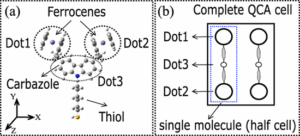TNANO Article in focus: July 2016
From the July 2016 issue of IEEE Transactions on Nanotechnology
Effect of a Clock System on Bis-Ferrocene Molecular QCA
by Ruiyu Wang, Azzurra Pulimeno, Massimo Ruo Roch, Giovanna Turvani, Gianluca Piccinini, Mariagrazia Graziano
T-NANO, Vol. 15, Issue 4, pp. 574 – 582, July 2016.

Abstract: Molecular quantum-dot cellular automata (mQCA) is found to be the most promising among all emerging technologies. It is expected to show remarkable operating frequencies (THz), high device densities, noncryogenic working temperature, and reduced power consumption. The computation relies on a new paradigm based on the interaction between nearby molecular QCA cells. This computation requires the aid of an external signal normally referred to as clock that enables/inhibits the molecular activity. The influence of clock on realistic molecules has never been deeply studied. In this paper, we performed a thorough analysis of the clock signal added to the molecular QCA cell based on an ad hoc synthesized bisferrocene molecule. Ab-initio simulations and further postprocessing of data have been used for characterizing the performance of bisferrocene molecule under the influence of a clock signal. Quantitative results on the molecule in terms of newly defined figures of merits, i.e., aggregated charge , equivalent voltage, and Vin-Vout transcharacteristic have been shown. Meanwhile, we demonstrate when and how much the presence of clock signal enhances or hinders the interactions between QCA molecules. These unprecedented data give a fundamental improvement to the knowledge on how information can be propagated through QCA devices. The results suggest directions to chemists, technologists, and engineers on how to proceed in the next steps for this promising technology.

